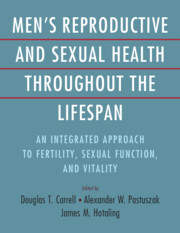 Men's Reproductive and Sexual Health Throughout the Lifespan
Men's Reproductive and Sexual Health Throughout the Lifespan Book contents
- Men’s Reproductive and Sexual Health throughout the Lifespan
- Men’s Reproductive and Sexual Health throughout the Lifespan
- Copyright page
- Contents
- Contributors
- Preface
- Section 1 An Introduction to Men’s Health Care
- Section 2 The Biology of Male Reproduction and Infertility
- Section 3 Clinical Evaluation and Treatment of Male Infertility
- Chapter 12 Office Evaluation of the Infertile Male
- Chapter 13 Medical Management of Male Infertility
- Chapter 14 Surgical Management of Male Infertility
- Chapter 15 Varicocele Repair in the Era of IVF/ICSI
- Chapter 16 Implementing Genetic Testing of Male Infertility in the Clinic
- Chapter 17 Andrological Care of the Patient with Spinal Cord Injury
- Chapter 18 Clinical Fertility Preservation Decision-Making for Prepubertal and Postpubertal Individuals with Male Gametes
- Chapter 19 Mental Health Considerations in the Infertile Male and Couple
- Section 4 Laboratory Evaluation and Treatment of Male Infertility
- Section 5 Medical and Surgical Management of Issues of Male Health
- Index
- References
Chapter 14 - Surgical Management of Male Infertility
from Section 3 - Clinical Evaluation and Treatment of Male Infertility
Published online by Cambridge University Press: 06 December 2023
- Men’s Reproductive and Sexual Health throughout the Lifespan
- Men’s Reproductive and Sexual Health throughout the Lifespan
- Copyright page
- Contents
- Contributors
- Preface
- Section 1 An Introduction to Men’s Health Care
- Section 2 The Biology of Male Reproduction and Infertility
- Section 3 Clinical Evaluation and Treatment of Male Infertility
- Chapter 12 Office Evaluation of the Infertile Male
- Chapter 13 Medical Management of Male Infertility
- Chapter 14 Surgical Management of Male Infertility
- Chapter 15 Varicocele Repair in the Era of IVF/ICSI
- Chapter 16 Implementing Genetic Testing of Male Infertility in the Clinic
- Chapter 17 Andrological Care of the Patient with Spinal Cord Injury
- Chapter 18 Clinical Fertility Preservation Decision-Making for Prepubertal and Postpubertal Individuals with Male Gametes
- Chapter 19 Mental Health Considerations in the Infertile Male and Couple
- Section 4 Laboratory Evaluation and Treatment of Male Infertility
- Section 5 Medical and Surgical Management of Issues of Male Health
- Index
- References
Summary
Male-factor infertility contributes significantly to the burden of infertility. Fortunately, many causes of male-factor infertility are amenable to surgical intervention. These interventions can be grouped broadly into three categories: 1) those that improve sperm delivery, including vasovasostomy, vasoepididymostomy, and transurethral resection of the ejaculatory ducts, for obstruction of the vas deferens, epididymitis, and ejaculatory ducts, respectively; 2) those that improve testicular function and optimize spermatogenesis, namely varicocelectomy; and 3) those that enable direct retrieval of sperm from either the epididymis (microsurgical epididymal sperm aspiration and percutaneous epididymal sperm aspiration) or testicle (testicular sperm aspiration and testicular sperm extraction). When used in conjunction with other assisted reproductive techniques, including IVF/ICSI, these surgical procedures have vastly improved the reproductive outlook for many subgroups of infertile men who had previous been considered completely infertile.
Keywords
- Type
- Chapter
- Information
- Men's Reproductive and Sexual Health Throughout the LifespanAn Integrated Approach to Fertility, Sexual Function, and Vitality, pp. 113 - 119Publisher: Cambridge University PressPrint publication year: 2023


